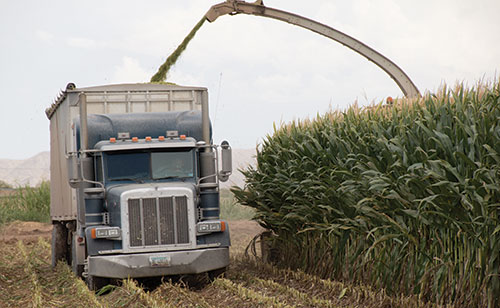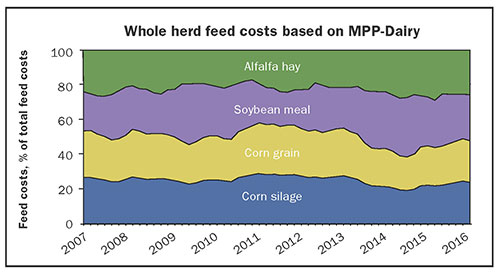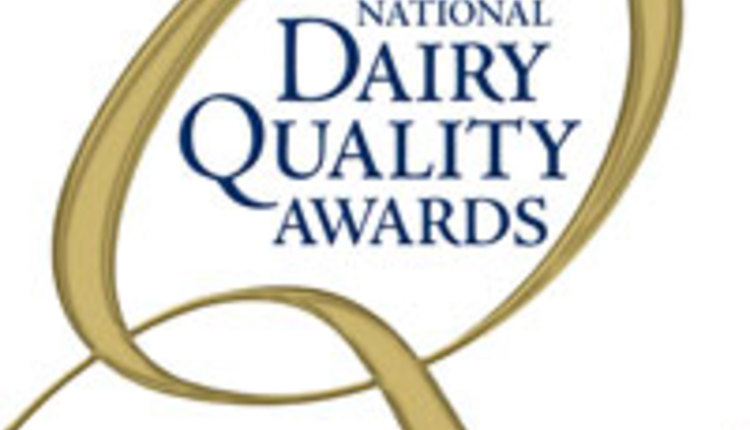
Corn silage harvest is just around the corner and could even be started in some parts of the country. Harvesting corn for silage may be one of the most important activities on a dairy farm. Let me discuss its implications and give some perspective to the importance of timing of corn silage harvest.
The figure depicts the proportion of feeding costs of each ingredient for the farm’s whole herd according to the Margin Protection Program for Dairy (MPP-Dairy). From an economic perspective, corn silage accounts for less than 30 percent of all feed costs for the dairy herd. From a nutritional perspective, however, corn silage represents 35 to 40 percent of the total amount of feed (on a DM basis) needed for the entire herd.
Corn silage is a relatively inexpensive feed widely used in dairy herds. This might not be “big news” for most of you, but the key here is whether you are prepared for the important event of corn silage harvest.
Decisions to makeHarvesting corn for silage requires several decisions, such as amount to harvest and ensile, harvest height, and harvest timing. To determine the least amount of corn needed to chop, and maybe the ensiling time, too, conduct a forage budget with your nutritionist. Document the current silage stocks and the short and midterm forage needs.
Even though farmers might be used to harvesting the same number of acres every year, performing a forage budget and revising the feeding program may help improve cash flow, especially during these times of low milk prices. As an example, remember that high-forage diets may improve income over feed costs, as homegrown forages are typically cheaper than concentrates.
Concerning harvest height, studies from the University of Delaware and the University of Georgia reported that dry matter yield dropped 11 percent on average with a range of 5 to 17 percent when cutting height was raised 8 to 14 inches, while milk yield rose only 2 to 6 percent. Based on the nutritional composition of the corn plant, there is no doubt that raising cutting height will lower the concentration of fiber and bump up the concentration of starch in the corn silage. However, growing forage stocks by harvesting greater yields might be more beneficial these days when cheap homegrown feed is valuable to sustain cash flows.
Time it rightHarvest timing can also be a major decision in terms of obtaining a high yield of good-quality forage. As such, harvesting time also needs good planning. Even before taking a step in the field, estimate how long it will take to complete the whole ensiling process. This can be particularly important on small farms using their own harvesting equipment.
Remember that climate conditions can delay harvesting, while the maturation process of the crop does not wait. Delays in harvest will typically yield more silage, but the digestibility of both the fiber and the starch can be diminished substantially. In addition to knowing how long it will take to harvest and ensile the corn, be sure to have all the harvesting and ensiling equipment ready, including oxygen barrier covers, bags, tire weights, and inoculants.

Closely monitor the stage of the crop to determine harvest time. If the crop is immature, the digestibility of the silage could be high at the expense of dry matter yield. In addition, if the crop is too immature (less than 30 percent dry matter), then fermentation and nutrient retention can be adversely affected.
The content and condition of the grain is the main determinant of the dry matter concentration of the corn silage. If the grain does not show floury endosperm, then the crop very likely will be too wet for ensiling. Also, consider that the stage of the grain may not reflect the dry matter concentration of the plant in hybrids with high stay-green characteristics.
Actually measure the dry matter concentration of the standing crop to ensure an adequate harvest time. Recently, the Department of Dairy Science at Virginia Tech released an educational video explaining how to monitor corn for silage to determine the best timing for harvest.
During stressful conditions, such as drought or heat that occurs around silking, both pollination and kernel development might be severely affected. When this occurs, concentrations of dry matter above 33 or 35 percent may never be reached unless the corn plant is left to mature. This also happens with certain forage sorghum varieties with low grain content. In these situations, measuring the dry matter concentration of the whole plant is even more important to decide the best harvesting time.
Deciding how much and when to harvest corn for silage is not a minor decision. Invest great effort in planning the silage harvest. Keep in mind that you may have little (if any) control over milk prices, but you can control harvest silage decisions. Dedication for a few weeks in the late summer or early fall will determine the amount and quality of feed for the entire next year. For this reason, create a plan for a successful corn silage harvest season.










